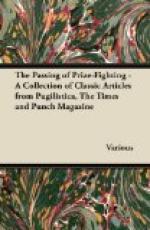WELLS, GARDNER, DARTON & Co. publish a very good selection of tales for young people. Among the best are Tom’s Opinion, a boy whose ever readily-expressed opinion is made to change pretty often; and Halt! by the same author. The title is suggestive of military manoeuvres, but it’s only a term for obeying quickly, which is hard to do sometimes. Gregory of the Foretop, Abbot’s Cleeve, and Going for a Soldier, are three books containing several stories suitable to mere grown-up young people,—so the sooner they grow up the better for the sale of the books. They are all edited by J. ERSKINE CLARKE, M.A.
FREDERICK WARNE & CO. give us Young England’s Nursery Tales, illustrated by CONSTANCE HASLEWOOD. Noah’s Ark, by DARLBY DALE, which is not the Ark of the nursery, but a story of the Norfolk Broads. Perhaps “Norfolk Broads” would have suggested stories that could not be told in a drawing-room. As to Bits about Horses for Every Day, selected and illustrated by S. TURNER,—well, what would horses be without “bits?” These are not tit-bits. Might do for a Bridle gift.
The Love of a Lady, by Miss ANNIE THOMAS, otherwise Mrs. PENDER CUDLIP, like most of this authoress’s novels, is full of interest. It is in the regulation three volumes, but appears as if it had wished to be in two, and would have been had not large type insisted upon the addition of a third tome. The love of a lady is transferred, during the course of the story, from an artist, who appears in the last chapter “in threadbare clothes, with broken, patched boots on his feet” (not on his Hands, bien entendu), to a “well-tailored” novelist. As the lady to whom “the love” originally belonged was “a popular illustrator,” it was only natural that the question of appearances should play an important part in determining its ultimate destination.
Mr. W. OUTRAM TRISTRAM is never so much in his element as when he revels in gore and guilt. In Locusta, in one bulky volume, he tells of “the crime” and “the chastisement.” The first is associated with “a house with curtained windows,” “an Italian swordsman,” “entombed,” and “a maimed lion,” and the second is developed in chapters headed, “The Hunter lets fly a Poisoned Shaft,” “The Silver Dish of Tarts,” “The First Victim Falls,” “A Dreadful Accuser,” and last, but not least, “The Vengeance is Crowned.” As the story begins in 1612, and ends with the words, “HENRY, Prince of WALES, art thou not avenged?” it will be seen, that Mr. W. OUTRAM TRISTRAM has seized this opportunity to pleasantly illustrate an incident from English history.




